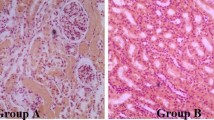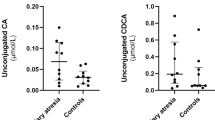Abstract
The effects of phenobarbital (5.4–7.5 mg/kg body weight) for 14 days were studied in four children with severe intrahepatic cholestasis (group I) and in four with a syndromatic type of paucity of intralobular bile ducts (group II). Phenobarbital administration resulted in a moderate improvement of pruritus in all patients. There was a significant decrease of bilirubin in serum (group I: from 4.8 to 2.7 mg/dl; group II: from 6.1 to 2.1 mg/dl); total bile acids (group I: from 416 to 337 μmol/l; group II: from 156 to 123 μmol/l) and cholesterol (group I: from 248 to 207 mg/dl; group II: from 351 to 292 mg/dl). Alkaline phosphatase activity increased from 929 to 1126 U/l in group I and from 1751 to 2360 U/l in group II. SGOT and SGPT activities remained unchanged in both groups. In group I total biliary lipid concentration and bile acid output increased from 0.09 to 0.17 g/dl and from 3.9 to 7.2 μmol/kg per 30 min, respectively. Molar percentages of cholesterol, phospholipids and bile acids in bile remained unchanged. In group II total lipid concentrations and bile acid output increased from 1.62 to 2.0 g/dl and from 27.8 to 39.1 μmol/kg per 30 min, respectively. The molar percentage of cholesterol decreased from 5.6 to 3.5 mol%.
The present results indicate that short term administration of phenobarbital has only minimal effects on biliary lipid metabolism in children with chronic intrahepatic cholestasis.
Similar content being viewed by others
References
Alagille D, Odievre M (1979) Liver and biliary tract disease in children. John Wiley and Sons, New York
Alagille D, Odievre M, Gautier M, Dommergues JP (1975) Hepatic ductular hypoplasia associated with characteristic facies, vertebral malformations, retarded physical, mental and sexual development and cardiac murmur. J Pediatr 86:63–71
Back P (1982) Phenobarbital-induced alterations of bile acid metabolism in cases of intrahepatic cholestasis. Klin Wochenschr 60:541–549
Becker M, Ruoff H-J, Rotthauwe HW (1980) Cyclic AMP in pancreatic and biliary secretion of children with chronic intrahepatic cholestasis and cystic fibrosis. Eur J Pediatr 134:217–225
Becker M, von Bergmann K, Rotthauwe HW, Leiss O (1984) Biliary lipid metabolism in children with chronic intrahepatic cholestasis. Eur J Pediatr 143:35–40
Bloomer JR, Boyer JL (1975) Phenobarbital effects in cholestatic liver disease. Ann Intern Med 82:310–317
Bouillon R, Reynaert J, Claes JH, Lissens W, DeMoor P (1975) The effect of anticonvulsant therapy on serum levels of 25-hydroxyvitamin D, calcium, and parathyroid hormone. J Clin Endocrinol Metab 41:1130–1135
Cohen BI, Raicht RF, Nicolau G, Mosbach EH (1975) Effects of phenobarbital upon bile acid synthesis in two strains of rats. Lipids 10:168–174
Collins DM, Shannon FT, Campbell CB (1981) Bile acid metabolism in mild arteriohepatic dysplasia. Aust N Z J Med 11:48–51
Coyne MJ, Bonorris GG, Chung A, Goldstein LI, Lahana D, Schoenfield LJ (1975) Treatment of gallstones with chenodeoxycholic acid and phenobarbital. N Engl J Med 292:604–607
Coyne MJ, Bonorris GG, Goldstein LJ, Schoenfield LJ (1976) Effect of chenodeoxycholic acid and phenobarbital on the rate limiting enzymes of hepatic cholesterol and bile acid synthesis in patients with gallstones. J Lab Clin Med 87:281–291
Deleze G, Paumgartner G (1977) Bile acids in serum and bile of infants with cholestatic syndromes. Helv Paediatr Acta 32:29–38
Genth CN, Bloomer JR, Hsia YE (1978) Efficacy and safety of long-term phenobarbital therapy of familial cholestasis. J Pediatr 93:127–132
Javitt NB (1976) Cholestasis in infancy. Status report and conceptual approach. Gastroenterology 70:1172–1181
Javitt NB, Morrissey KP, Siegel E, Goldberg H, Gartner LM, Hollander M, Kok E (1973) Cholestatic syndromes in infancy: diagnostic value of serum bile acid pattern and cholestyramine administration. Pediatr Res 7:119–125
Kooh SW, Reilly BJ, Fraser D (1979) Pathogenesis of rickets in chronic hepatobiliary disease in children. J Pediatr 94:870–874
Linarelli LG, Williams CN, Phillips MJ (1972) Byler's disease: fatal intrahepatic cholestasis. J Pediatr 81:484–492
Linarelli LG, Hengstenberg FH, Drash AL (1973) Effect of phenobarbital on hyperlipemia in patients with intrahepatic and extrahepatic cholestasis. J Pediatr 83:291–299
Miller NE, Nestel PJ (1973) Altered bile acid metabolism during treatment with phenobarbitone. Clin Sci Mol Med 45:257–262
Mosbach EH, Salen G (1974) Bile acid biosynthesis: pathways and regulation. Amer J Dig Dis 19:920–928
Redinger RN, Small DM (1973) Primate biliary physiology. VIII. The effect of phenobarbital upon bile salt synthesis and pool size, biliary lipid secretion and bile composition. J Clin Invest 52:161–172
Rotthauwe HW, Becker M, Bosch Ch (1981) Progressive intrahepatische Cholestase. Monatsschr Kinderheilkd 129:515–520
Sachs L (1974) Angewandte Statistik. Springer, Berlin Heidelberg New York
Schoenfield LJ, Sjoevall J, Perman E (1967) Bile acids on the skin of patients with pruritic hepatobiliary disease. Nature 213:93–94
Sharp HL, Mirkin BL (1972) Effect of phenobarbital on hyperbilirubinemia, bile acid metabolism and microsomal enzyme activity in chronic intrahepatic cholestasis of childhood. J Pediatr 81:116–126
Shefer S, Hauser S, Mosbach EH (1972) Stimulation of cholesterol 7 alphahydroxylase by phenobarbital in two strains of rats. J Lipid Res 13:69–70
Stiehl A, Thaler MM, Admirand WH (1972) The effects of phenobarbital on bile salts and bilirubin in patients with intrahepatic and extrahepatic cholestasis. New Engl J Med 286:858–861
Stiehl A, Thaler MM, Admirand WH (1973) Effects of phenobarbital on bile salt metabolism in cholestasis due to intrahepatic bile duct hypoplasia. Pediatrics 51:992–997
Stiehl A, Becker M, Czygan P, Froehling W, Kommerell B, Rotthauwe HW, Senn M (1980) Bile acids and their sulphated and glucuronidated derivates in bile, plasma, and urine of children with intrahepatic cholestasis: effect of phenobarbital treatment. Eur J Clin Invest 10:307–316
Williams CN, Kaye R, Baker L, Hurwitz R, Senior JR (1972) Progressive familial cholestatic cirrhosis and bile acid metabolism. J Pediatr 81:493–500
Author information
Authors and Affiliations
Rights and permissions
About this article
Cite this article
Becker, M., von Bergmann, K., Rotthauwe, H.W. et al. Effects of phenobarbital on biliary lipid metabolism in children with chronic intrahepatic cholestasis. Eur J Pediatr 143, 41–44 (1984). https://doi.org/10.1007/BF00442746
Received:
Accepted:
Issue Date:
DOI: https://doi.org/10.1007/BF00442746




